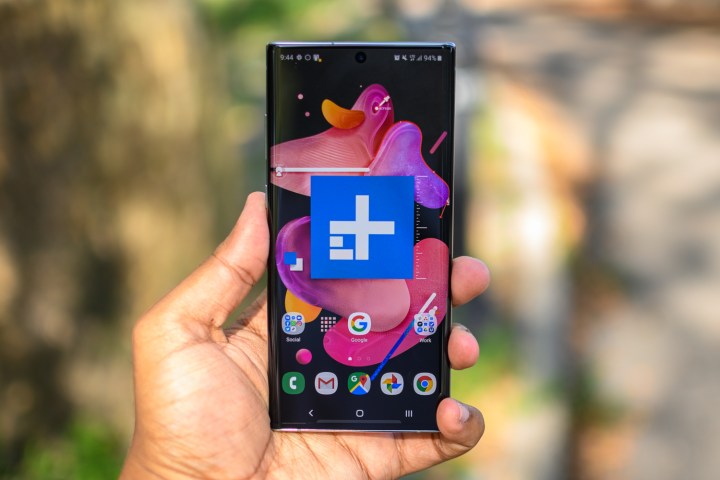Samsung’s Galaxy Note 10 Plus and Google’s Pixel 3 XL represent two of the biggest, baddest phones on the Android platform, but the Note is close to double the current price of the Pixel. So, what do you actually get for the extra $500, and is it worth it? We put them head-to-head to find out.
Specs
| Samsung Galaxy Note 10 Plus | Google Pixel 3 XL | |
| Size | 162.3 × 77.2 × 7.9mm (6.39 × 3.04 × 0.31 inches) | 158 × 76.7 × 7.9mm (6.2 × 3 × 0.3 inches) |
| Weight | 196 grams (6.91 ounces) | 184 grams (6.49 ounces) |
| Screen size | 6.8-inch Dynamic AMOLED | 6.3-inch P-OLED |
| Screen resolution | 3,040 × 1,440 pixels (498 pixels per inch) | 2,960 x 1,440 pixels (523 pixels per inch) |
| Operating system | Android 9.0 Pie | Android 9.0 Pie |
| Storage space | 256GB, 512GB | 64GB, 128GB |
| MicroSD card slot | Yes | No |
| Tap-to-pay services | Google Pay, Samsung Pay | Google Pay |
| Processor | Qualcomm Snapdragon 855 | Qualcomm Snapdragon 845 |
| RAM | 12GB | 4GB |
| Camera | Quad lens 16-megapixel ultra-wide-angle, 12MP standard, 12MP telephoto, and ToF DepthVision rear, 10MP front | Single lens 12MP rear, dual 8MP lenses front |
| Video | 2160p at 60 frames per second, 1080p at 240 fps, 720p at 960 fps | 2,160p at 30 fps, 1,080p at 120 fps, 720p at at 240 fps |
| Bluetooth version | Bluetooth 5.0 | Bluetooth 5.0 |
| Ports | USB-C | USB-C |
| Fingerprint sensor | Yes, ultrasonic in display | Yes, rear capacitive |
| Water resistance | IP68 | IP68 |
| Battery | 4,300mAh
QC2.0, AFC, USB Power Delivery 3.0 Qi Fast wireless charging 2.0 |
3,430mAh
USB Power Delivery 2.0 Qi wireless charging |
| App marketplace | Google Play Store, Galaxy Store | Google Play Store |
| Network support | T-Mobile, AT&T, Verizon, Sprint | T-Mobile, AT&T, Verizon, Sprint |
| Colors | Aura Glow, Aura White, Aura Black, Aura Blue | Just Black, Clearly White, Not Pink |
| Price | $1,100 | $600 |
| Buy from | Samsung | Google, |
| Review score | 4.5 out of 5 stars | 4 out of 5 stars |
Performance, battery life, and charging

Glancing at the spec sheet, you’re sure to see some wide disparities in certain areas. Things start out tamely as far as the processor goes — Qualcomm’s Snapdragon 855 in the Note 10 Plus versus last year’s flagship processor, the Snapdragon 845, in the Pixel. OK, next? 12GB RAM on the Note 10 Plus compared to 4GB on the Pixel 3 XL. Yes, that one is a little tougher to swallow.
It’s pretty clear that the Note 10 plus will handle bigger tasks and more of them, expressing little effort in doing so. While the Pixel 3 XL is a smooth operator, the
When it comes to keeping your phone juiced up and ready to go, the
And if you want even faster charging, you can spend $50 more for the 45W adapter to juice the
Winner: Samsung Galaxy Note 10 Plus
Design and durability

When it comes to design, we don’t need to tell you anything you can’t already see. The Note’s colors are dazzling, and the device is sleeker, more futuristic, and has a screen-to-body ratio that screams top-notch.
On the other hand, the top notch on the
Both are made from aluminum and glass (Gorilla Glass 6 on the Note and Gorilla Glass 5 on the Pixel) and are therefore likely to shatter from a bad drop, but the Note 10 Plus’s slimmer bezels and more exposed curved glass certainly make it less likely to survive a drop than the
The
Winner: Samsung
Display

Comparing the displays in-hand you’ll notice the
And oh my word that notch on the Pixel. The Note’s punch-hole camera is tiny and forgettable but I’m still trying to forget the Pixel’s in-ground pool of a notch, and I’m not even looking at it.
Winner: Samsung
Camera

The cameras are another area where you’ll find some distinct differences. The
The Pixel takes a very different approach, relying on much more software and fewer cameras. The 12-megapixel main camera is the only rear-facing snapper, giving the
The ToF sensor isn’t missed much on the Pixel either, thanks to the exquisite software algorithms which adeptly separate foregrounds and backgrounds and apply very pleasing blur to portrait shots. This isn’t an option for video as it is on the Samsung, but given the Note’s imperfect results here, it’s not something you’re likely to miss on the Pixel. There is a dual-camera setup for the 8-megapixel selfie-cams on the
Both of these phones are going to shoot very well in daytime or ideal conditions, but the
The
Winner: Google
Software and updates

Samsung and Google have very different takes on the Android 9 Pie platform. The
You can expect
If you’re looking for a consistent and reliably updated experience for a longer period of time, the Pixel is arguably the best
Winner: Google
Special Features

The
Firstly, there’s the S Pen. Now able to act as a remote to control media and gesture through certain camera functions, the pen is more than a writing utensil. Of course, you can still write with it too, and the newest Microsoft integration enables the
More Microsoft collaboration can be found in the Note 10 Plus’ native ability to sync notifications, messages, and soon, phone calls with a Windows device. There’s also a forthcoming feature called Galaxy Play Link, which further bolsters this connection, allowing users to stream their PC games to the
Lastly, the Note 10 offers support for Samsung’s desktop-interface-from-a-phone feature, DeX, now adding the ability to launch this platform on a Mac or PC with only a USB-C cable.
The
With the majority of unique features found on the
Winner: Samsung
Price and availability
OK. Maybe this one’s a little unfair, but cost is a serious consideration when buying a phone. The
Overall Winner: Samsung Galaxy Note 10 Plus
If you’re looking for a cutting-edge device, it’s hard not to quickly say, “go for the Note 10 Plus” but it’s also hard to say, “go spend $1,100 for a phone.” The
Lose a couple of cameras and some — er, a lot of sex appeal — and you’ll have a very good device right now in the
Editors' Recommendations
- Google Pixel Watch 3: news, rumored price, release date, and more
- The best Samsung Galaxy Note 10 Plus cases and covers
- Samsung Galaxy S21 FE vs. Google Pixel 6: Battle of affordable flagships
- Early OnePlus 10 Pro renders reveal Samsung Galaxy S21 Ultra-inspired camera bump
- Google Pixel 3 and Pixel 3 XL: Everything you need to know



